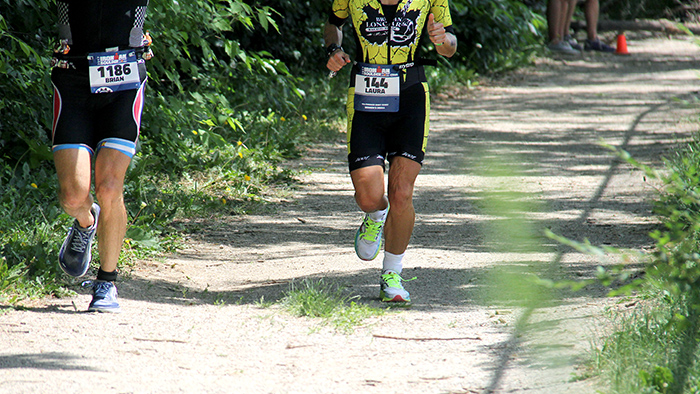Some athletes dread T2, and know they’ll be watching their times slip through the whole run. Luckily you don’t have to be a professional runner to make the most of this leg. Here are some tips to get fitter, more efficient, and stop fearing your finish time.
Improve your movement economics
Running on the treadmill helps to build the habit of maintaining a high running rhythm, even as fatigue increases. This is critical to good running in the long-course triathlon. Mobility is also important. Systematic rolling, stretching and mobility drills performed wisely are very effective, though running fast on a regular basis generally solves most mobility problems!
Run regularly on tired legs
Plan challenging running workouts after challenging cycling workouts, and consider brick training an indispensable part of your training program. The sequence of training sessions both during the day and the microcycle in general is a key aspect of the pre-race preparation phase. I recommend that experienced athletes run a few hours or one day after hard swimming or cycling training. It will help to automate the desired movement patterns and improve your movement economics at the relevant speeds.
Run a lot
Run a lot in the preparatory phase – no other variable correlates to such an extent with the race results as training volume. But remember to increase your running mileage gradually, as no other variable correlates to such an extent with injuries as too rapid an increase in the running mileage!
Be fresher off the bike—or the swim!
If you note significant differences between your results when running “dry” and when running in a triathlon, look for progress in the water, and on the bike. The deficit you feel in a race probably has to do with the energy you’ve spent on the other two legs.
In Poland, it is still common to hear that “endurance training is performed on the bike and on the run.” It’s true that an excellent running shape will be useless if you leave the T2 half-dead, dehydrated and with a considerable energy deficit. Hundreds of studies have been devoted to the relationship between the bike and the run, and it’s important to train methodically for both.
A lesser-discussed issue is the impact of the swim on running times. It is worth looking at your swimming training not only from the perspective of the results achieved, but also the energy spent. Jan Frodeno swims 40 kilometres a week to develop general aerobic endurance, not to swim faster. There are no shortcuts; you really have to spend the time to develop aerobic endurance in those swim-specific muscles. Once you can swim efficiently you’ll be able to enter your run as fresh as possible.
Get A Little Leaner
No, you don’t have to look like a Kenyan runner. Too much weight loss, or trying to copy the training of professional track athletes will not make your quadriceps hurt less! Just keep in mind that “kilograms don’t run.”
Athletes’ Choice Winner: Triathlon
This article was one of the most popular on TrainingPeaks in 2018. To see all the winners, visit the Athletes’ Choice 2018 Page.



